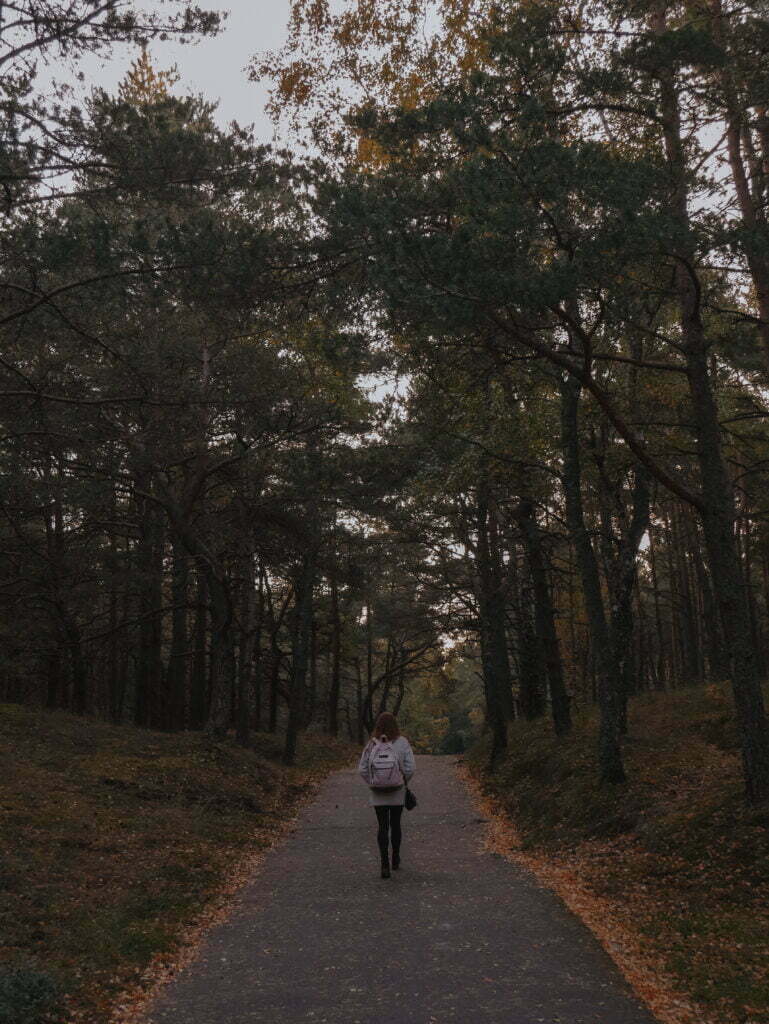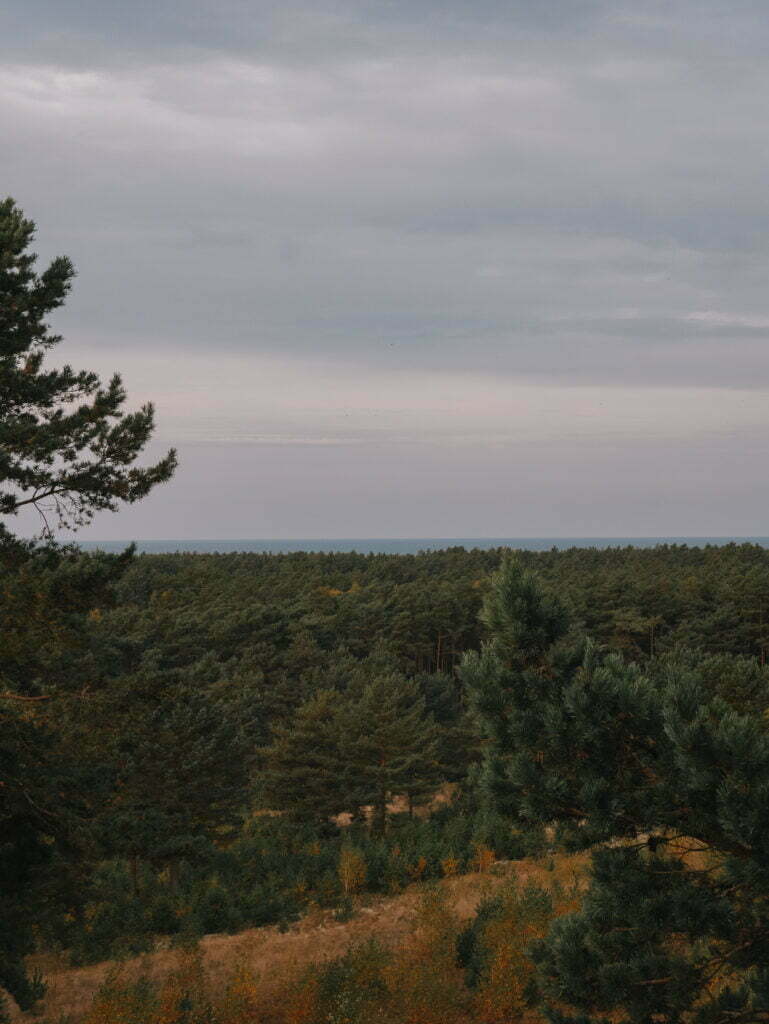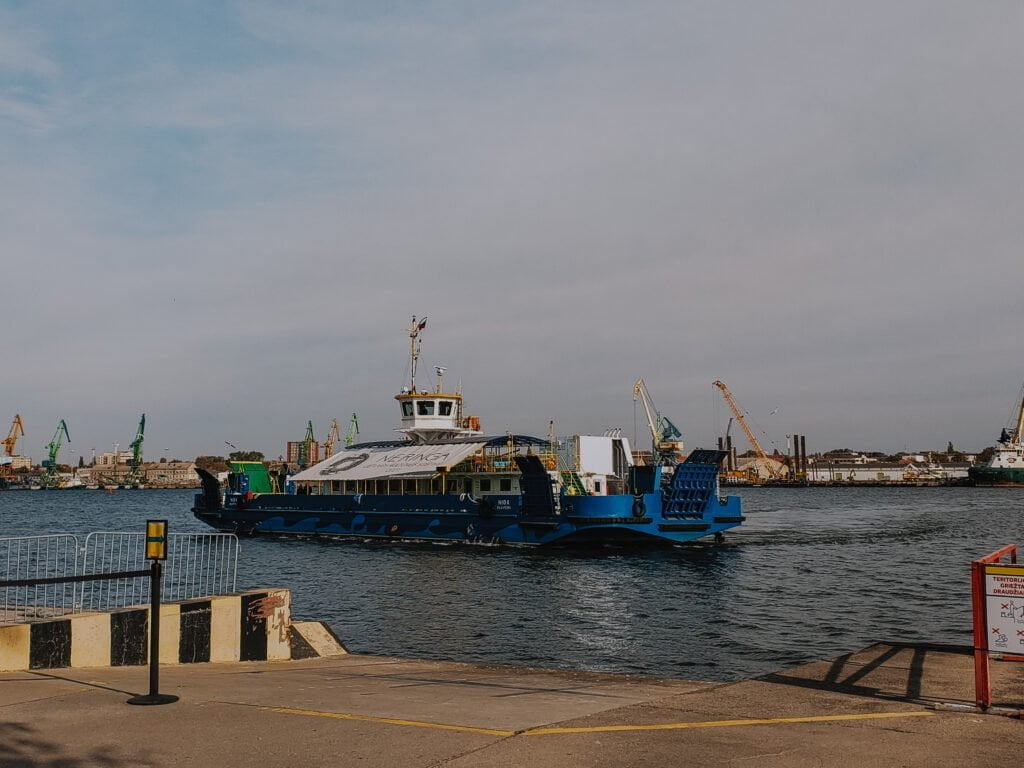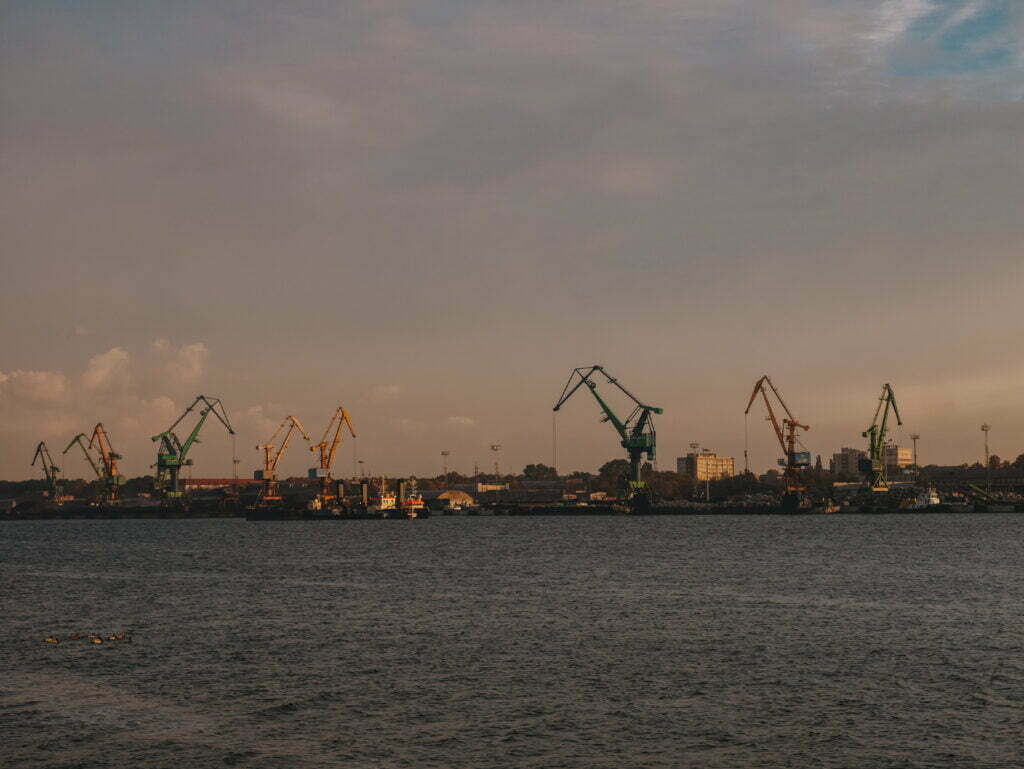The Curonian Spit is a long, very thin peninsula that runs along the coast of Lithuania. Legend says that a giant named Neringa created the spit to protect the people from the furious waves of the Baltic Sea. Large dunes, beautiful pine forests, and sandy beaches make up this stretch of land and a variety of wildlife thrives here, making it a wonderful place to enjoy the outdoors.
In addition to the beautiful natural spaces that make up the Curonian Spit National Park and UNESCO World Heritage site, small towns and historic fishing villages dot the peninsula. Part of the spit belongs to Lithuania, and another section is part of the small Russian territory of Kaliningrad. We did not cross into the Russian area of the Curonian Spit, so this post will focus on visiting the Lithuanian side.

When to Visit the Curonian Spit
The best time to visit the Curonian Spit would be the summer. The warmer weather and longer days are better for enjoying the beach. Additionally, more of the restaurants and accommodation in the area are open and there are more events and other activities going on. If you do visit in the summer and want to stay in one of the towns on the spit, we recommend booking accommodation and ferry tickets in advance since it can get quite busy.
Had we visited in the summer, we would have likely stayed on the Curonian Spit and spent more time here. However, we visited in October when it was chilly and overcast, so we opted for a day trip from Klaipėda. We didn’t have the most ideal conditions, but we heard that this was one of the most beautiful places in Lithuania, so we didn’t want to miss it!
Most of the accommodation and restaurants were closed for the season. While we didn’t get to enjoy the beaches and bustling summer vibes, the national park was extremely quiet and we enjoyed a peaceful day in nature after spending time in Kaunas and Vilnius.

Getting to the Curonian Spit from Klaipėda
There are multiple ferry options that cycle between Klaipėda and some of the towns on the Curonian Spit. Only during the summer do the ferries connect Klaipėda to Juodkrantė and Nida. Otherwise, they run just to Smiltynė. For updates, contact info, more schedule details, and to purchase your ticket, click here.
Note: The linked Keltas website linked above hasn’t seemed to be allowing some people to access it to view timetables. In that case, we’d say your best bet would be to reach out to the Klapėda Information Center to see if they can provide updates on ferry schedules and ticketing. Alternatively, you can visit the ferry terminal in the days leading up to your planned trip to the Curonian Spit if possible.
Old Terminal
The ferries leaving from the Old Terminal in Klapėda take passengers and bikes to Smiltynė and back. As mentioned above, alternate routes to Juodkrantė and Nida may be available in the summer. In the fall and winter, ferries run from 7:30 a.m. until 9:15 p.m., cycling about every hour. Rides are more frequent in the summer. The cruise across the water takes less than 10 minutes.
Tickets cost €1.70 for a round trip ticket for both individual passengers and those with bikes. Note that the ticket is only good for one day. So if you are staying on the Curonian Spit, you’ll need to purchase an additional ticket for the day you plan to return to Klaipėda. You can purchase tickets online beforehand (if the site is working), or at the Klaipėda terminals.
Since we didn’t have a car, we crossed the lagoon on the Old Ferry. We purchased our tickets at the machine at the terminal the morning of departure because we were visiting during off-season and weren’t worried about it being busy. The ferry and terminal had indoor and outdoor seating and restrooms.

New Terminal
The ferries leaving from the New Terminal in Klaipėda take passengers, bikes, cars, and trucks/buses to Smiltynė, arriving a bit further south. This ferry runs 24 hours a day and the trip takes less than 10 minutes.
Tickets cost €1.70 for a round trip ticket for both individual passengers and those with bikes. If you are transporting your car across, it costs €23. These prices include the passenger as well. As with the Old Ferry, you can purchase your tickets online beforehand or at the Klaipėda terminal.

Getting Around the Curonian Spit
Private Car
For the most flexibility, a car may be the best option for exploring the Curonian Spit. Since many of the highlights are spread out along the length of the spit, this ensures that you can hit the places you want to see without being confined to the bus schedule or limited to the distance you can cover without a car.
The downsides to bringing a car are the limited parking in some areas during busy times of year, the extra cost to take it on the ferry and for the national park fee, and the long waits you may encounter when the ferry terminal is busy.
Public Bus
There is public transport running along the Curonian Spit, connecting Smiltynė to Nida and some of the towns in between. We honestly couldn’t find much information on the schedules of these vans beforehand. The best schedule we could find is on the Lithuanian bus website. Enter in Smiltynė to Nida and your date, then click trip schedule to view the stops and times. Additionally, you could find more information at the Klaipėda Information Center before you head to the Curonian Spit or at the Smiltynė Information Center.
Once on the Curonian Spit, we saw bus schedules posted at the bus stops. Even in low season, there were a few vans/small buses cycling up and down the peninsula and we never had to wait long. Note that there are some buses reserved for residents and employees who commute there for work. Buses were pretty cheap and we just paid as we boarded. Price depends on the distance, but make sure to have small change.

Taxis
We have heard and read that there are some taxis that serve the Curonian Spit. According to locals, most of these are located in Nida/Neringa, but some can be seen in the northern area around Smiltynė. It is recommended to hire one for the day if you do choose to utilize taxis so that it is guaranteed that they will be waiting for you when you are done at various attractions. Otherwise you might not be able to find one to get you to the next spot. We didn’t see any taxis when we visited in the off season.
Biking & Walking
Biking is a popular way to explore the Curonian Spit. There are bike rental agencies in Klaipėda and in some towns on the spit like Nida and Juodkrantė. For more information on biking the trail on the Curonian Spit, click here. Many of the trails we saw were nicely paved and fairly level, and we think having a bike would be a great way to get around had we been staying longer here.
The Curonian Spit is absolutely beautiful and there are many cute towns and hiking trails, so do some exploring on foot. However, we recommend combining walking with other modes of transport to see more of the park because it is pretty large. Unless spending multiple days making your way along the spit, it would be difficult to see it all on foot.

Tour
Lastly, if you’d like a more structured approach to visiting the Curonian Spit, there are various tours available. Many tours leave from Klaipėda and spend the day hitting the highlights in the national park. There are various itineraries available and tours can be booked in Klaipėda or on sites like Get Your Guide and Viator.
Tours are definitely the more expensive way to see the park, but can be a good option if you’d like the convenience of having transport, the ferry, and other details organized for you.
Some Extra Notes on Visiting the Curonian Spit
Curonian Spit National Park Fee
Before we dive into some of the great activities on the Curonian Spit, we want to mention the fee required to visit Curonian Spit National Park. Most of the spit is within the protected area, so if you are entering the spit by your own vehicle, you must pay the fee. It costs €10 year-round for motorcycles and mopeds and €10 to €50 for a passenger car, depending on the time of year. The entrance is valid for the duration of your time in the park.
The fee can either be paid at the toll booth south of Smiltynė or the booth at the border station south of Nida. You can now also buy the pass online – learn more here. Keep your pass/proof of purchase with your vehicle.

Activities
Some of the activities below are only available in the peak summer months. For example, all of the sailing tours and evening boat trips were not running when we visited in October. But, no matter the time you visit, you can still fill at least a full day exploring the park and enjoying its beauty.
Things to Do on the Curonian Spit
There are many ways to enjoy your time on the Curonian Spit whether you visit for the day or plan to stay a while longer.
Explore the Hill of Witches
Visiting The Hill of Witches, or Raganų Kalnas, is one of the unique activities on the Curonian Spit. A trail leads through the woods near Juodkrantė to a series of wood carvings. The carvings depict legendary characters from Lithuanian folk tales, from witches and devils to dragons.
Some of the carvings are formed into benches, and there are even a group of sculptures that have interactive elements like foot holds for climbing and a seesaw. All of the installations are pretty cool and the forest scenery surrounding them is beautiful.

Visit the Lithuanian Sea Museum
On the far northern end of the Curonian Spit outside of the national park sits the Lithuanian Sea Museum and Aquarium. Here, you can learn about Baltic Sea marine life and the history of exploration and navigation in the area.
Access to the exhibits costs €9 per adult in the low-season months of September through May and €13 June through August.
Hit the beach
We didn’t spend much time at the beach because it was chilly, windy, and the sea was rough. But we did walk the path through the woods to the beach near Smiltynė as the sun rose and it was incredibly beautiful. Many of the beaches along the Curonian Spit are long and sandy, with plenty of space to post up for the day.

Water Sports
If you’re looking for something a little more action-packed than hanging on the beach, there are various other ways to enjoy the sea. There are kayaking and windsurfing tours, sailing/boat trips, pedal boats, and fishing opportunities.
Many of these activities are offered as a tour from Klaipėda. If you aren’t taking a tour from there, your next best bet for finding boat tours along the dunes and other activities is to head to Nida.
Spot wildlife
There is a variety of wildlife that calls the Curonian Spit home. The area is particularly popular for birding because there are many cormorants that nest here. One of the main spots to see the bird colony is a viewing platform in the woods near Juodkrantė. You may also see them fishing along the coast and from other viewing platforms.
There weren’t many cormorants around when we visited in the fall, but we did see foxes, herons, falcons and other birds. You may also spot deer, boar, beavers, and even moose!

Take in the views from the dunes
There are multiple dunes to climb up along the Curonian Spit to get a great view of both the Curonian Lagoon and the Baltic Sea. These higher dunes are wonderful spots to watch sunrise and sunset. Some great dunes to climb include Parnidis, the Dead Dunes and Nagliai Nature Reserve (extra €5), Artist Dune, and Vecekrūgas Dune.
Parnidis Dune is perhaps the most popular. There is a nice trail leading up it, the views are beautiful, and there is a large sundial at the top. From here, you can see the Valley of Death and look into the Kaliningrad portion of the Curonian Spit. Vecekrūgas is the highest dune on the spit. It is more pine-covered, but there are open spaces at the top to take in the views.
Additional trails and other dunes are pretty well-marked on Google Maps if you’re looking for other spots to explore! As you explore the dunes, please stay on designated trails. The landscape is ever-changing as some of the dunes migrate naturally. So keeping to the trails helps to preserve the landscape and prevent erosion around the paths.

Visit Some of the Museums on the Curonian Spit
Aside from the Lithuanian Sea Museum, there are other museums and galleries along the Curonian Spit. The most popular options include the Amber Gallery (€2.50) to learn about Baltic amber and its uses, the Thomas Mann Museum (€3.00) to learn about Thomas Mann and see where the German writer spent his summers, and the Curonian Spit History Museum (€2.00) to learn about the history of Nida and life on the Curonian Spit.
For other exhibit options in the area, click here.
Stroll through the streets of Nida and Juodkrantė
Nida and Juodkrantė are a couple of the larger villages on the Curonian Spit and have the most options for accommodation and dining on the peninsula. As you stroll through these peaceful towns, you’ll come across colorful traditional houses, pretty paths along the lagoon, and unique sculptures.

See the Lighthouses of the Curonian Spit
A few lighthouses sit on the Curonian Spit that have long been used to guide ships and warn of approaching storms.
In the 1870s, Nida Lighthouse was built atop Urbas Hill. Today, visitors can climb the lighthouse for excellent views over the surrounding area. It costs €5 per adult.
There is also the Pervalka Lighthouse built in 1900. This one sits just off the Curonian Spit on a small manmade island and can be seen by boat or from the shore as you explore north of the small town of Pervalka.
Lastly, there is the Juodkrantė Lighthouse, which was built in the mid-1900s. This metal structure is still an important part of the navigational system today. Visitor’s cannot climb this lighthouse and it sits tucked deep in the woods. So, we don’t recommend going out of your way to visit this spot unless you’re looking for a nice stroll in the forest or happen to be at the nearby Sound Catcher.
Events and More
There are other activities, such as cultural events, Christmas tree lightings, and various celebrations that take place on the Curonian Spit. Check the Neringa Facebook page for promotions and other information on upcoming events.
Like this Post? Pin it!




